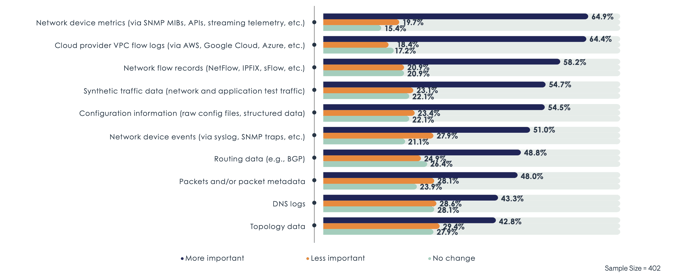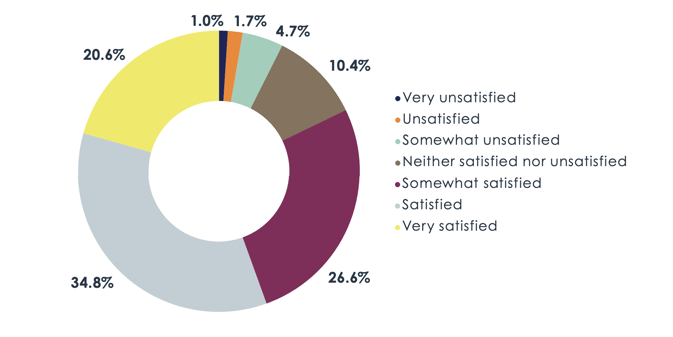October 26, 2022

Moving from Network Monitoring to Network Observability

Written by: Jeremy Rossbach
The Latest Research from Enterprise Management Associates (EMA) Details What to Look for in a Network Observability Solution
If you’re finding it a little difficult to sift through all the varying, often conflicting information surrounding the topic of network observability, you’re certainly not alone. The good news is that EMA’s latest industry report, “Network Observability: Delivering Actionable Insights to Network Operations,” offers the following authoritative definition:
“Network observability refers to a network monitoring system that collects a complete and diverse set of network data to provide deep visibility and actionable insights into the current and future state of a network. Those actionable insights include network performance, application performance, network security, and end-user experience.”
As the author of this research, Shamus McGillicuddy, EMA’s Vice President of Research, puts it, ”Specificity is the best remedy for the marketing whiplash that IT professionals have experienced when trying to understand the idea of network observability.”
As a seasoned IT professional and marketer, I can admit that network observability is definitely a buzzword being thrown around by many IT vendors these days. But with the evolving nature of networking and network operations, we definitely need more than just traditional network monitoring. These legacy approaches are simply not equipped to address the operational visibility gaps introduced by work-from-anywhere models, cloud migrations, and SaaS adoption.
At Broadcom Software, we believe that traditional network monitoring software needs to move beyond the network edge so teams can quickly and easily isolate issues that affect the end-user experience, whether those issues are occurring on networks they’re managing, or on those run by third parties. In today’s digital world, the user experience is shaped more by networks outside of the four walls of the data center than those inside. The bottom line is that network observability should be about ensuring reliable connections—no matter where a user may be or what device or network they may be using.
“Network observability refers to a network monitoring system that collects a complete and diverse set of network data…”
As EMA’s research reveals, operations teams need more data than traditional SNMP polling alone can provide.

Figure 1: Based on a survey of 402 enterprise IT stakeholders, the EMA report looks at the types of network data that respondents feel are more or less important to network management and monitoring, and it reveals how those perceptions have changed over the last three years.
To do effective network operations triage, teams must harness intelligence from alarms, faults, network flows, performance data, network configurations, DNS, logs, and more. It is only with this complete operational visibility that teams can make fast, intelligent triage decisions and reconcile root causes faster. By gaining visibility into the user experience, whether that experience is reliant upon networks you own or not, your teams can troubleshoot quickly and easily. Your teams can even troubleshoot within the context of a specific network device, interface, or virtual network function.
By collecting all the relevant data formats and data streams, solutions enable teams to establish a pinpoint focus on what matters. Today, this is the only way to avoid spending hours searching for the needle in the proverbial haystack that today’s networks represent. Network monitoring software should empower administrators and reduce escalations—not prolong triage times. Missing one ingredient of this recipe could mean that the root cause is hidden from you for hours…or even days.
“.... to provide deep visibility and actionable insights into the current and future state of a network.”

Figure 2: EMA research reveals that less than half of respondents believe their current network monitoring software can fully answer any question about their network, whether pertaining to performance, capacity, compliance, security, or some other topic.
We have already established that complete data is needed to have full visibility into every aspect of network delivery, and this data is needed for any network that user transactions may traverse. But just having the data in front of you isn’t enough. What really separates network monitoring from network observability is gaining the visibility to immediately isolate the root cause and gain actionable insights for remediation.
Whether you are a level-one NOC operator or a SD-WAN architect, you need deep analysis and granular insights. You also need alarm noise reduction so you can be sure you’re focusing on the real issue. To establish this visibility, you need full network path analysis and real-time synthetic testing of network delivery and performance.
In addition, network observability solutions should provide immediate root cause detection while enabling the entire network team to dive as deep as they need into such areas as flows, packets, logs, BGP route changes, and even the performance of ISP or cloud network devices. Imagine you can claim “It’s not our network”—and do so in seconds versus hours. Imagine you can show the ISP that it's their edge device that is dropping packets. Imagine that you could allow your SD-WAN architect to test network delivery across every single hop for their new VMware SD-WAN (formerly VeloCloud) deployment, before it goes into production. For today’s network operations teams, this all becomes possible with deep visibility.
“Those actionable insights include network performance, application performance, network security, and end-user experience.”

Figure 3: EMA research reveals only about 20% of respondents are very satisfied with the ability of their network monitoring or network observability tools to provide actionable insights from network data.
When it comes to actionable insights for network performance, teams can assess the network monitoring software’s ability to pinpoint where a network delivery issue occurs, and which organization is responsible for resolving it. Toward this end, teams need hop-by-hop diagnostics that help isolate the user environment, last-mile ISP networks, upstream peering, and the application service provider environment.
In the network security area, solutions can provide actionable insights based on more reliable intrusion detection metrics from the network side. With these insights, security teams can focus their root cause analysis on the appropriate network infrastructure. They can also understand how the performance of edge network security devices like secure web gateways might be affecting the user experience. This visibility would also be very useful in secure access service edge (SASE) environments.
Within the context of application performance or end-user experience, solutions can provide actionable insights that go beyond the user login screen. By leveraging synthetic transactions, teams can track critical milestones from the front to the back end of the application infrastructure. This allows you to see exactly where business-critical apps might be slowing down and degrading the user experience, so you can escalate the issue or take appropriate action.
Conclusion
There is no doubt that network observability is a buzzword at the moment and I am sure a new term will come along in a few years to replace it. But if you’re looking for a vendor that can help advance your network monitoring, just remember that what matters most is whether a solution makes the day-to-day management of network operations as easy as possible for your teams. Look for a solution that can collect every network metric available, that can scale to support the largest networks in the world, and that offers operational visibility into external networks, such as those run by ISPs and cloud providers. Ask yourself these questions:
- Is this solution saving us money by helping us avoid downtime?
- Is the solution helping my team do more with less staff?
- Can I now retire any redundant tools?
To learn more, join Shamus McGillicuddy, EMA Vice President of Research, at an upcoming webinar. This webinar will reveal some of the key insights from EMA’s network observability research. EMA surveyed more than 400 IT professionals and did in-depth interviews with network engineers and architects from some of the largest enterprises in the world. Follow this link to learn more and register: Network Observability: Delivering Actionable Insights to Network Operations.

Jeremy Rossbach
As the Chief Technical Evangelist for NetOps by Broadcom, Jeremy is passionate about meeting with customers to identify their IT operational challenges and produce solutions that fit their business and network transformation goals. Prior to joining Broadcom, he spent over 15+ years working in IT, across both public...
Other resources you might be interested in
Top 3 Trends Defining Network Observability in 2026
Discover the three specific trends that will define network observability in 2026. See how unified observability and predictive AI will shape the landscape.
Rally Office Hours: December 18, 2025
Rally Office Hours features an AI-driven artifact breakdown tool that creates child items from features/stories. The Q&A covers capacity planning, forecasting and burnup charts.
Why 2025 Shattered the Old Rules of Network Management
This post reveals the five key lessons network operations leaders learned in 2025—and how they need to respond to be successful in 2026.
The 2026 VMUG Report: Why Network Observability is the Heart of the New VCF Era
Get the top takeaways from the VMUG Cloud Operations and VCF User Experience Report 2026. See why network observability is key to successful VCF 9 migrations.
Automic Automation Cloud Integration: SAP S/4 HANA Application Jobs Integration
Simplify your SAP S/4HANA job management. Integrate with Automic Automation for central configuration, monitoring, and orchestration of all your enterprise jobs.
Automic Automation Cloud Integration: OpenSSH Integration
Master Open SSH automation. Use Automic Automation for centralized control, secure file transfer, command execution, and full job monitoring.
Rally Office Hours: December 11, 2025
Discover Rally's new Ancestors field, static query box deprecation, non-conflicting saves, plus a dashboard demo and query writing tips.
3 Questions I Expect You to Ask Me
Ask these questions to gain a deeper understanding of a vendor. Find a partner who can solve today’s challenges and prepare you for what’s next.
Carrier-Grade Network Observability: A Technology Brief for Telco Network Operations
Network Observability by Broadcom unifies data to provide contextual, AI-enabled insights for superior service availability, accelerated MTTR and improved MTTI, reduced operational costs, and the...